THANK YOU!
YOUR PURCHASE OF THESE BOOKS SUPPORTS THE WEB SITES THAT BRING TO YOU THE HISTORY BEHIND OLD AIRFIELD REGISTERS
Your copy of the Davis-Monthan Airfield Register (available in paperback) with all the pilots' signatures and helpful cross-references to pilots and their aircraft is available at the link. 375 pages with black & white photographs and extensive tables
---o0o---
The Congress of Ghosts (available as Kindle Edition eBook) is an anniversary celebration for 2010. It is an historical biography, that celebrates the 5th year online of www.dmairfield.org and the 10th year of effort on the project dedicated to analyze and exhibit the history embodied in the Register of the Davis-Monthan Airfield, Tucson, AZ. This book includes over thirty people, aircraft and events that swirled through Tucson between 1925 and 1936. It includes across 277 pages previously unpublished photographs and texts, and facsimiles of personal letters, diaries and military orders. Order your copy at the link.
---o0o---
Military Aircraft of the Davis Monthan Register, 1925-1936 (available in paperback) at the link. This book describes and illustrates with black & white photographs the majority of military aircraft that landed at the Davis-Monthan Airfield between 1925 and 1936. The book includes biographies of some of the pilots who flew the aircraft to Tucson as well as extensive listings of all the pilots and airplanes. Use this FORM to order a copy signed by the author, while supplies last.
---o0o---
Art Goebel's Own Story (available as free PDF download) by Art Goebel (edited by G.W. Hyatt) is written in language that expands for us his life as a Golden Age aviation entrepreneur, who used his aviation exploits to build a business around his passion. Available as a free download at the link.
---o0o---
Winners' Viewpoints: The Great 1927 Trans-Pacific Dole Race (available as Kindle Edition eBook) is available at the link. This book describes and illustrates with black & white photographs the majority of military aircraft that landed at the Davis-Monthan Airfield between 1925 and 1936. The book includes biographies of some of the pilots who flew the aircraft to Tucson as well as extensive listings of all the pilots and airplanes. Use this FORM to order a copy signed by the author, while supplies last.
---o0o---
Clover Field: The first Century of Aviation in the Golden State (available in paperback & Kindle Edition) With the 100th anniversary in 2017 of the use of Clover Field as a place to land aircraft in Santa Monica, this book celebrates that use by exploring some of the people and aircraft that made the airport great. 281 pages, black & white photographs.
---o0o---
YOU CAN HELP
I'm looking for information and photographs of this airplane to include on this page. If you have some you'd like to share, please click this FORM to contact me.
---o0o---
SPONSORED LINKS
HELP KEEP THESE WEB SITES ONLINE
FOR YOUR CONVENIENCE
You may NOW donate via PAYPAL by clicking the "Donate" icon below and using your credit card. You may use your card or your PAYPAL account. You are not required to have a PAYPAL account to donate.
When your donation clears the PAYPAL system, a certified receipt from Delta Mike Airfield, Inc. will be emailed to you for your tax purposes.
---o0o---
STINSON SM-6000-B NC10840
SUNK IN THE CARIBBEAN
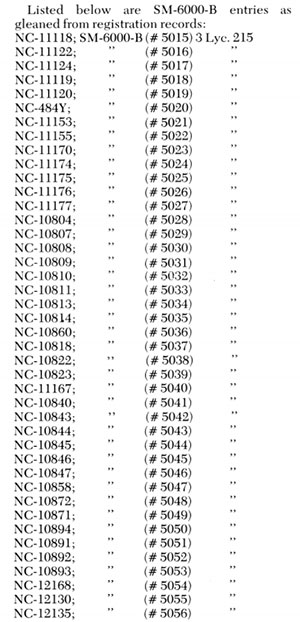 |
This airplane was a Stinson model SM-6000-B, S/N 5041. It was manufactured, inspected and approved for sale June 16, 1931 by the Stinson Aircraft Corporation, Wayne, MI. Called the "Model T," it was a large, high-winged, tri-motored monoplane. It was powered by three nine-cylinder Lycoming R-680 engines of 215HP each, giving it a cruise speed of about 115MPH. It was, for the time, a high-capacity passenger and freight carrying airplane. It was flown by a crew of one. I have no photographs of this airplane. If you can help, please let me KNOW.
At least 42 examples of the model were manufactured by the Stinson Aircraft Corporation, Wayne, MI. In passenger configuration the Model T could seat 8-11 people and their baggage. This REFERENCE, volume 5, page 59, provided the table at right and states that the SM-6000-B's, "Excellent performance, inherent safety, and a compatible nature helped to promote the popularity and the longevity of the SM-6000-B, so we find that at least 25 examples were still flying actively in 1939, and some even for years afterwards." It could maintain an altitude of 6,000 feet with only two engines operating, even when fully loaded.
NC10840 appeared in the Grand Central Air Terminal (GCAT) Register at least 136 times between June and January 19, 1932. As a new airplane, it was a liner in the employ of Century-Pacific, Ltd. It wore Century-Pacific Ltd. livery and carried passengers, mail and freight along the west coast from San Diego to San Francisco. Century-Pacific was organized by Oxnard Field Register pilot E.L. Cord.
During 1932, Century-Pacific was absorbed into the workings of the American Airways sytem, thus American inherited some 24 SM-6000-Bs and other craft in the merger. American operated the Stinsons for about three years, then offered them for sale as used aircraft to the highest bidder. We can trace NC10840 through this series of exchanges, because, thanks to the generosity of a site visitor, we have the complete registration and airworthiness records for NC10840.
Regarding the registration information, below, NC10840 was sold as a new aircraft on June 17, 1931 to Century Pacific Air Lines of Chicago, IL. As delivered from the factory, the Lycoming radial engine serial numbers were 488 (center engine), 450 (right) and 489.
NC10840 had a normal life for a Golden Age airplane, meaning it worked hard and died young. Starting life as an airliner for two transport companies, it was sold to several individuals and a Caribbean airline. It sank in the ocean near the U.S. Virgin Islands at age fifteen. The paper trail comprising the chain of custody follows. First, the bill of sale.
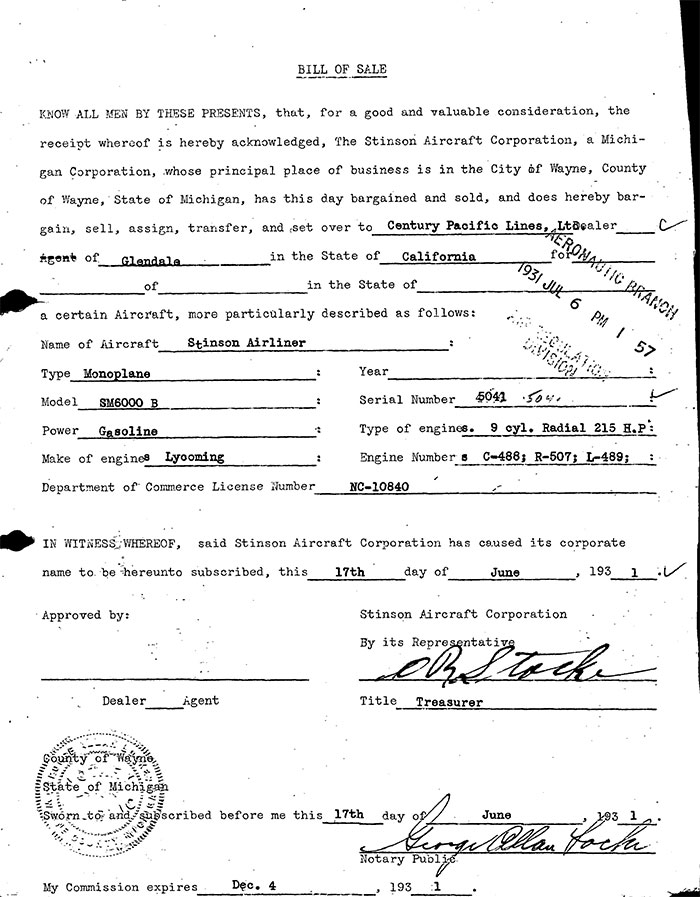 |
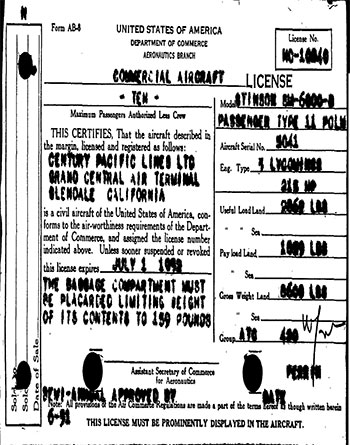 |
Registration was applied for on June 16, 1931 and approved to carry ten passengers. The first registration card is at left, with an expiration date twelve months later. By law this card had to be carried in the airplane at all times, along with specified weight placards for passengers and baggage.
As of 1932, Century-Pacific operated thirteen Stinson Model SM-6000-B aircraft, of which nine were recorded in the GCAT Register during 1931. They were NC10810, NC10813, NC10814, NC10840, NC10843, NC10844, NC10845, NC10846 and NC10847.
Frustratingly, no pilot information was noted in the Register by tower Operator A.J. Lygum or others that allowed us to associate particular pilots with any given flights by NC10840 or any of the other Century-Pacific Stinsons.
A three-page letter, below, from the Department of Commerce (DOC) dated February 25, 1932 clarified the registration currency of Century Pacific's airplanes (plus two Stinson Juniors used by the air line). Of real interest in this letter is a listing of the pilots employed (either full-time or part-time?) by Century-Pacific.
Only one of these fourteen listed pilots appeared by name in the GCAT Register. He was Harold Sweet who was recorded nearly 200 times giving scenic recreational rides in the Ford trimotor NC5577. This activity was completely unrelated to Century-Pacific business.
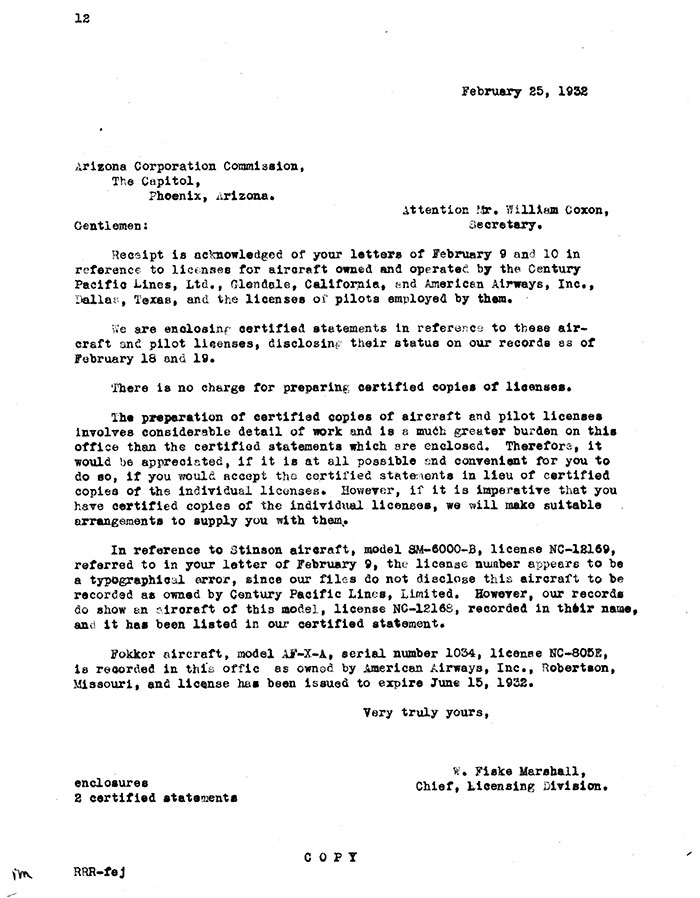 |
Some of the other pilots appeared in other Registers. For example, James L. Giffin appeared in the Davis-Monthan Airfield Register on November 14, 1931 flying the Stinson Jr. NC10866 operated by Century-Pacific. And Walton H. Smiley landed at Tucson November 16, 1931 flying the SM-6000-B NC10847. In addition, NC10872 and NC10893 were Register airplanes, visiting the Davis-Monthan Airfield on August 18, 1931, and between September 4 and 9, 1931, respectively.
 |
Likewise, Blackmore, Joseph Plosser, Williams, Muncie, Medler, Ben Catlin, Glennan, Robert Cantwell, and Erickson were signed in one or more Registers, some flying the Century-Pacific airliners.
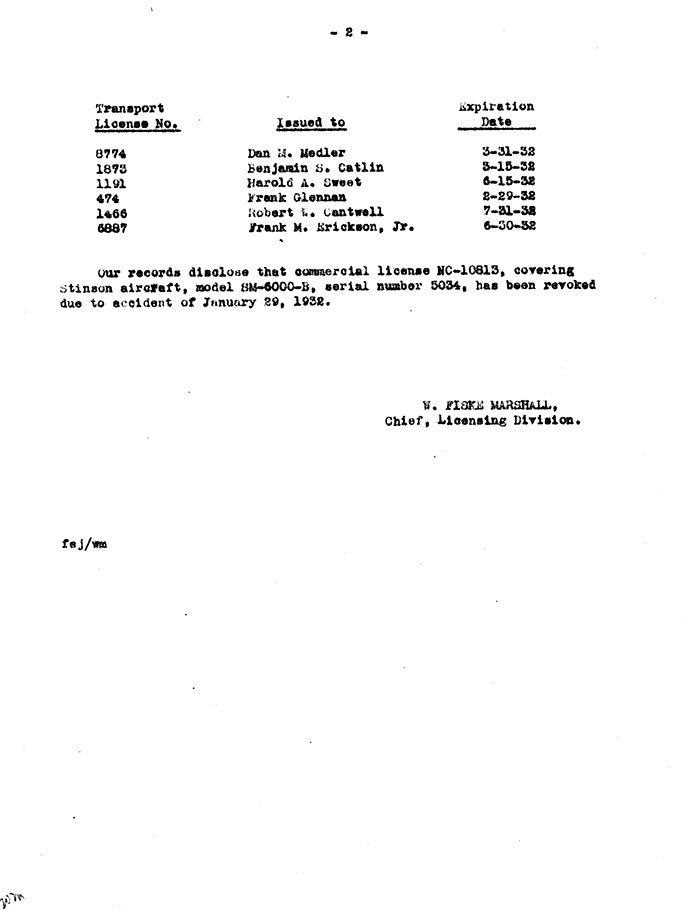 |
NC10840 was transferred to American Airways, Inc. as of March 31, 1932. A DOC memorandum was entered into the aircraft's records on May 2, 1932, below, which summarized the transfers of fourteen Century Pacific Stinsons to American Airways. The maintenance records for the airplane show that American performed a thorough weight & balance calculation on NC10840 on July 9, 1932.
 |
 |
NC10840 was moved to Love Field, Dallas, TX with American Airways and operated there successfully through at least July, 1933. On April 16, 1935, NC10840 was transferred to Monarch Air Service, Chicago, IL. The official transfer document is below.
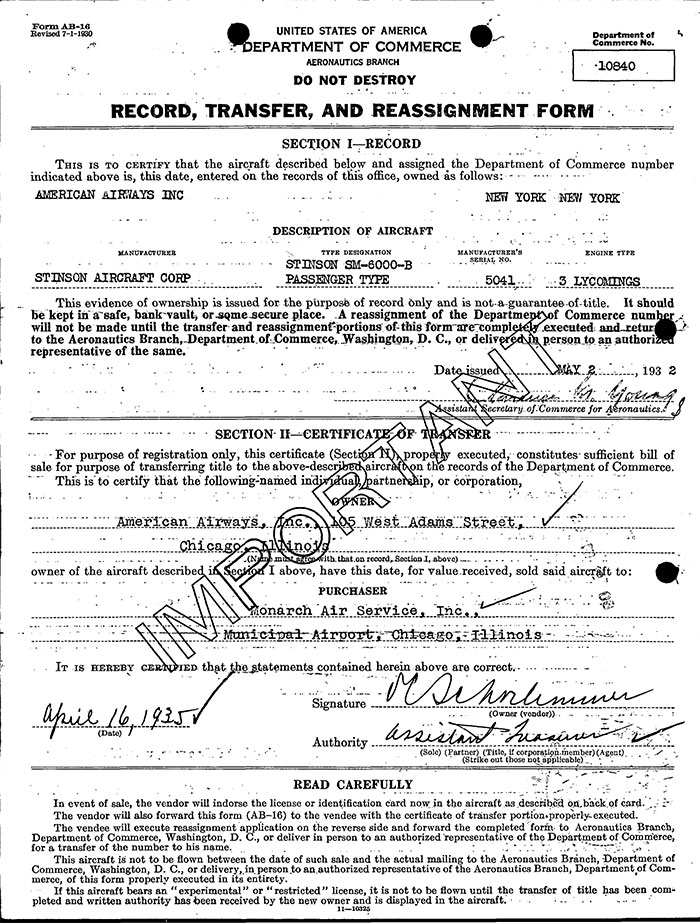 |
A lien was held by American Airways against the airplane. The records show that lien was released August 28, 1935.
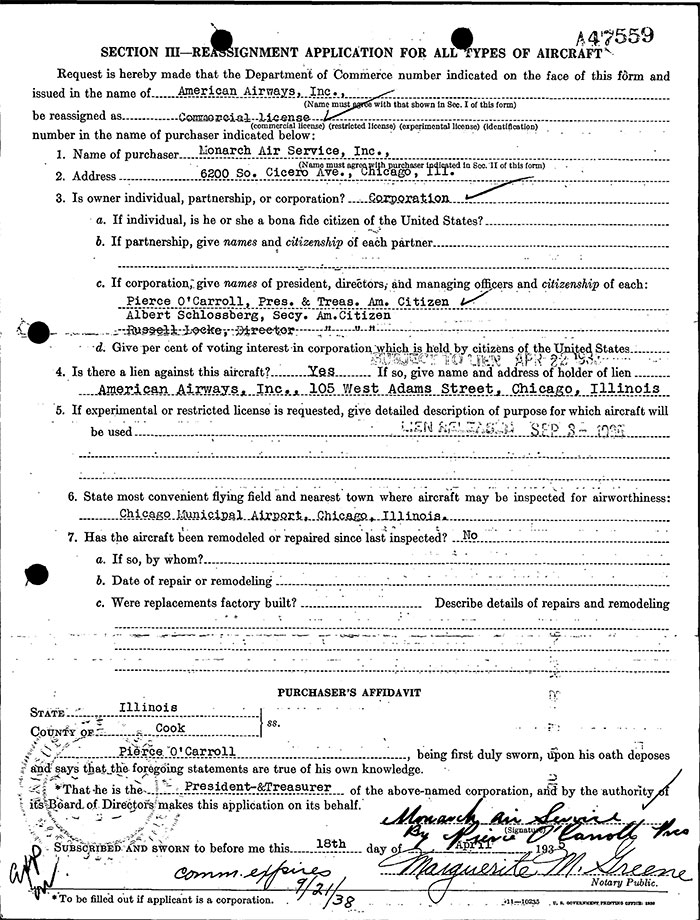 |
Almost simultaneous with the lifting of the lien, the license of NC10840 was also lifted as described in the following DOC letter of August 22, 1935. Although dirt itself is not a basis for grounding an aircraft, the fact that the records were not up to date is a violation of regulations. Note, too, that two pilots had their pilot licenses and a mechanic's license suspended for flying the airplanes for hire while knowing they were not in unairworthy condition.
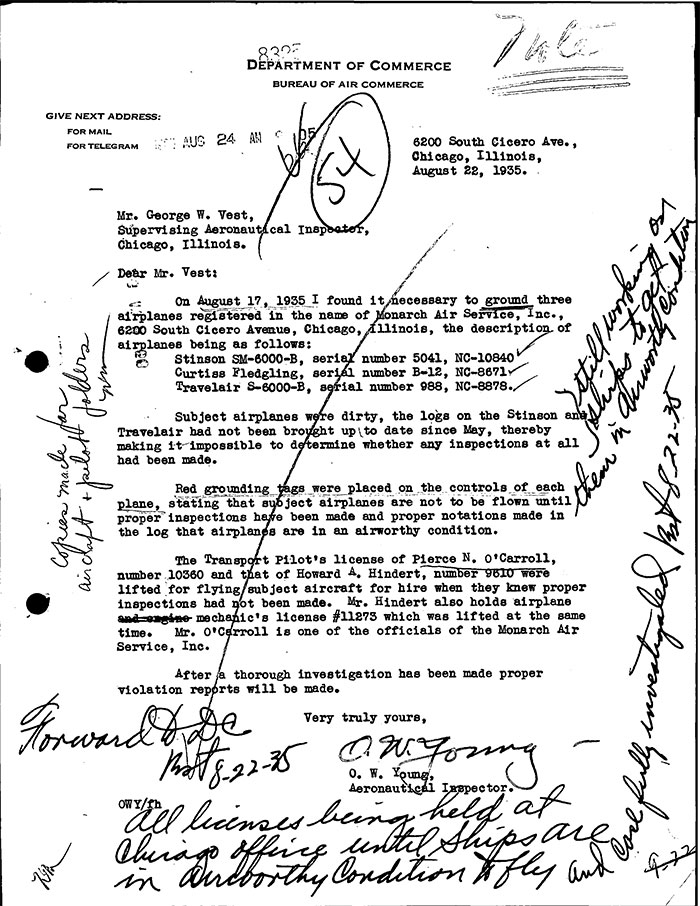 |
Another letter in the airplane's file shows that Hindert's mechanic license was later revoked effective August 17, 1935 because of his demonstrated incompetence in maintaining NC10840 and the other two aircraft (neither Register aircraft), and allowing them to fly in an unairworthy condition. Another letter dated September 19, 1935 reported the suspension of pilot Pierce O'Carroll's pilot license for a period of thirty days effective September 15, 1935.
While all this was happening in the aftermath of the grounding of NC10840, the airplane was sold again to Mary Jane Seaman, president, on behalf of her company, the Georgia Flying Service of Atlanta, GA, as documented in the following bill of sale. At some point the engines had been changed. The agreed price was $2,200 at Chicago, IL.
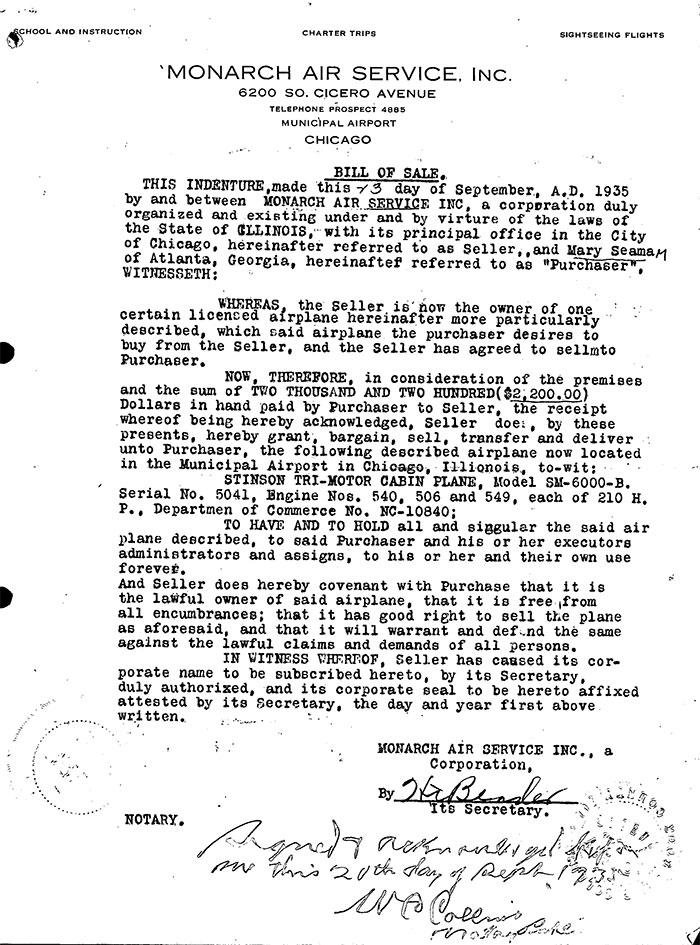 |
 |
Then began a brisk series of changes in ownership. The airplane was then registered in the name of Georgia Flying Service to expire May 1, 1936. On July 1, 1936, NC10840 was transferred to Russell L. West of Waycross, GA, an individual with private pilot license 25892. It was registered in his name. On December 2, 1936, West transferred the airplane to Atlantic & Gulf Coast Airlines, Inc., Savannah, GA.
In July, 1938 the airlines performed major repairs and refurbishments on NC10840. These are summarized below.
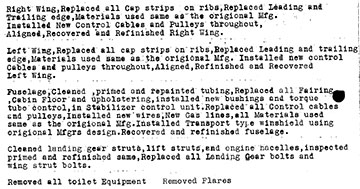 |
The repairs performed above were probably in anticipation of selling the airplane. Atlantic & Gulf Coast Airlines transferred the airplane to Dennis Powelson (Commercial pilot certificate 20588) of Mercedita, Puerto Rico, and he applied for registration on August 25, 1938 to expire July 15, 1939. A maintenance report of August 2, 1939 showed the airplane had accumulated 4,215 flight hours. Powelson's registration is above, right. The airplane was now in Puerto Rico flying daily for Caribbean & Atlantic Airlines out of Ponce on the south coast. Although not specified in the airplane's records, Powelson was the president of the airline.
Interestingly, the 1940 U.S. Census placed Powelson living with his wife, both age 32, in Santurce, PR with two servants in a home rented for $55 per month. He had been living in Santurce since at least 1935.
A bill of sale dated April 30, 1940 documented the transfer of NC10840 from Powelson to Caribbean & Atlantic. Indeed, Powelson signed the document as both seller and buyer! At about the same time, Powelson and Caribbean & Atlantic assumed ownership of NC10814, linked above. By 1945 Powelson was the majority stockholder in, and president of, Caribbean-Atlantic Airlines, Inc.
NC10840 was then re-registered under the airline's name on April 30, 1940 to expire August 15, 1940, then September 15, 1941. It had accumulated 4,468 total flight hours. The last airworthiness certificate I examined for the airplane was dated July 19, 1941. There was no registration record for the airplane during WWII.
The next document in the record was a two-page form requesting permission to fly the airplane over three days from Puerto Rico to Barranquilla, Colombia, below. The sole pilot and navigator would be Powelson, and he was to carry a mechanic. Note that a radio was installed.
 |
Note the route of flight and the justification that the over-water portions of the voyage would be no longer than those flown routinely over the airline's routes since 1938. The purpose of this flight, according to the records, was for the sale of the aircraft in Colombia.
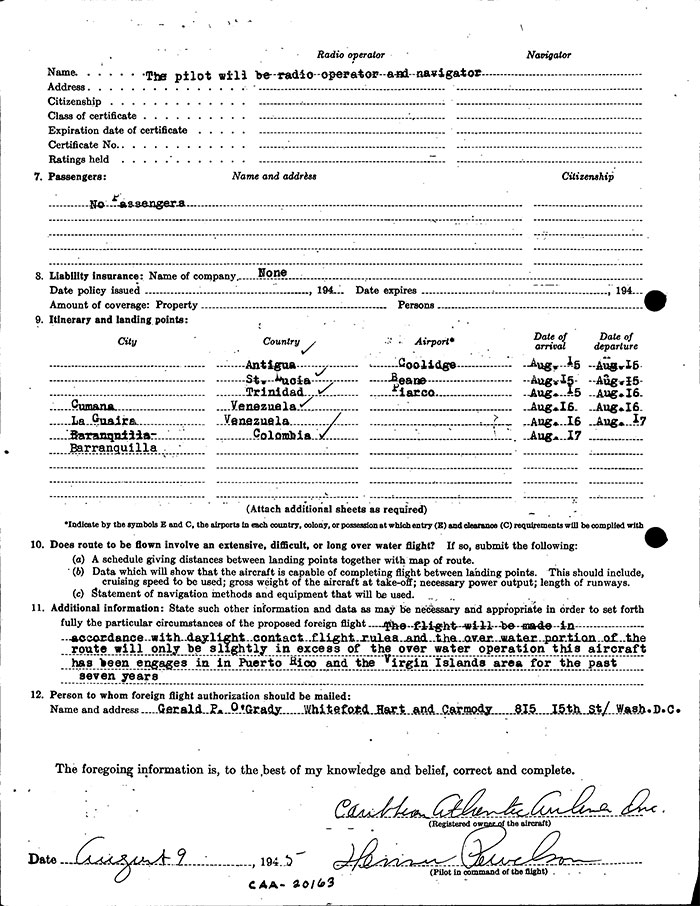 |
The best laid plans, however, are destined to be foiled by bureaucracy. It seems that an export license was required for the airplane before it could be moved, as well as official permissions to land at some of the countries and fields along the route. In the end, the trip was delayed by these bureaucratic requirements and the airplane was not flown to Colombia. Rather it was sold in August, 1945 to Eugene H. Bell of San Juan, PR.
The next entry in the record was a letter from the Civil Aeronautics Administration (CAA) dated April 7, 1948 that reminded Bell that he had the legal obligation to register the airplane and have it inspected before he flew it. Bell responded on April 19th with the letter below.
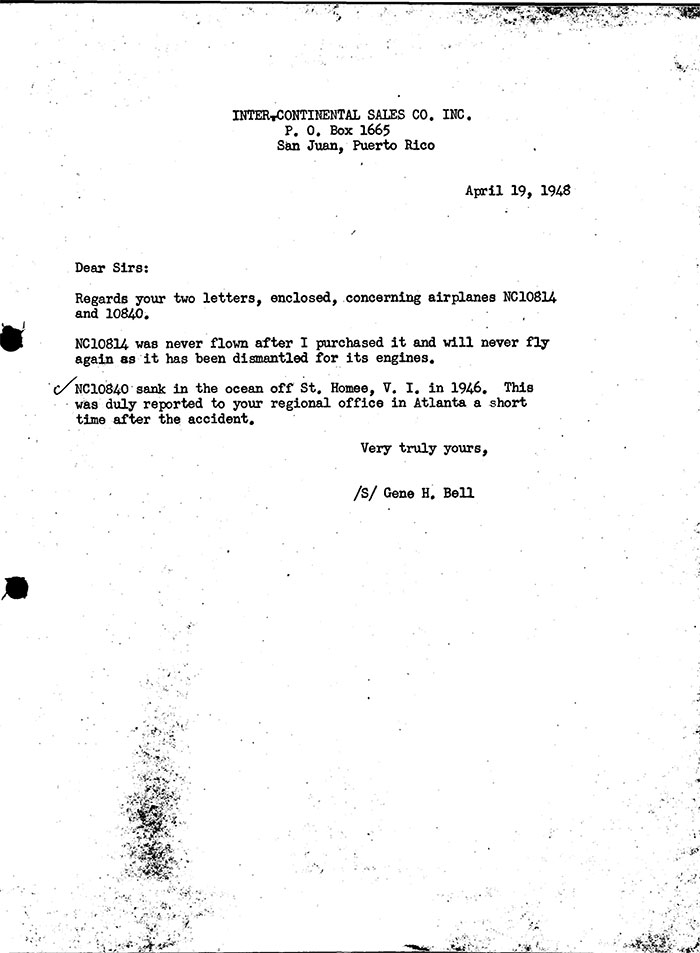 |
Thus we discover the fates of both NC10814 and NC10840.
---o0o---
SPONSORED LINKS
THIS PAGE UPLOADED: 11/30/16 REVISED:
